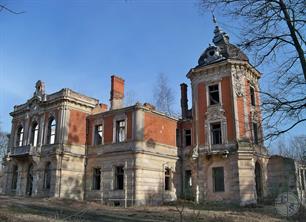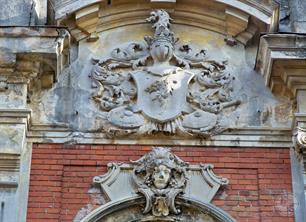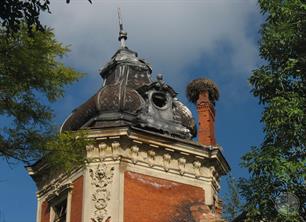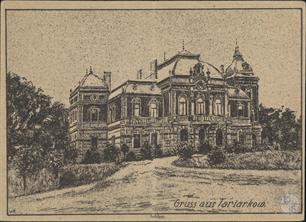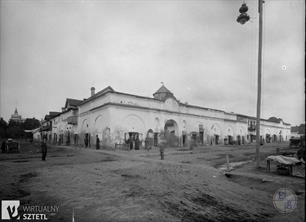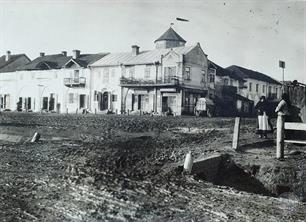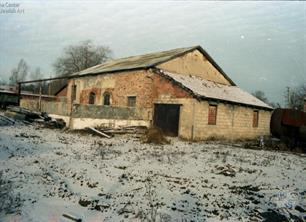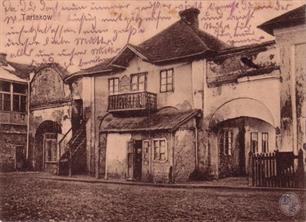Tartakiv
Sources:
- Jewish encyclopedia of Brockhaus & Efron
- Virtual Shtetl. Tartakow
- Jewish Cemeteries Initiative. Tartakiv Jewish Cemetery
Photo:
- Center for Jewish art. Synagogue in Tartakiv
- Biblioteka Narodowa Polona. Tartakow
- Portal Polska-org.pl. Tartakow (Тартаків)
- Austrian National Library. Tartakow: Ortsstrasse (3.III.1918)
- Neovitaha777, Haidamac: Wikipedia. Тартаків
- Jewish encyclopedia of Brockhaus & Efron
- Virtual Shtetl. Tartakow
- Jewish Cemeteries Initiative. Tartakiv Jewish Cemetery
Photo:
- Center for Jewish art. Synagogue in Tartakiv
- Biblioteka Narodowa Polona. Tartakow
- Portal Polska-org.pl. Tartakow (Тартаків)
- Austrian National Library. Tartakow: Ortsstrasse (3.III.1918)
- Neovitaha777, Haidamac: Wikipedia. Тартаків
Chervonohrad district, Lviv region
For the first time, Tartakiv (ukr. Тартаків) is mentioned in the documents of 1415.
In 1685, at the request of the owner of settlement Magnat Casimir Potocki Tartakiv received Magdeburg law.
Based on the privilege, a town hall was erected with a tower and around it - a baroque market. To protect against the attack of robbers, the market was transformed into a fortress.
In 1685, at the request of the owner of settlement Magnat Casimir Potocki Tartakiv received Magdeburg law.
Based on the privilege, a town hall was erected with a tower and around it - a baroque market. To protect against the attack of robbers, the market was transformed into a fortress.
The Jews were presumably present in Tartakiv from the year of the town’s foundation.
By the beginning of the 18th century, the Jewish community emerged.
The Belz Hasidism predominated.
The owner of Tartakov, Potocki, allowed in the 1740s to establish a Jewish printing house in order to damage the Jewish printing house in Zhovkva. But in 1754, the printing house was taken away by the Jews and donated to the Jesuits.
In 1765, 779 Jews lived in Tartakiv,
in 1880 - 770 Jews (70,5% of the total population),
in 1900 - 976 Jews (67,6 of the total population),
in 1921 - 1,039 Jews (69,9% of the total population)
Jewish encyclopedia of Brockhaus & Efron provides the information of the Union calendar in 1910, which indicates 4869 Jewish residents, but this information is doubtful. The same encyclopedia speaks about Tartakiv as a seedy town in 1912.
In 1913, Havrot-Lina and Bikur Holim societies were functioning.
A public library was opened.
During WWI, the community were attacked by the Cossacks and Circassian army.
In terms of social inclinations, both the influence of Zionism and the assimilationist aspirations were noticeable - most Jewish children attended Polish schools.
They earned their living as traders (in cornflower, building materials, cattle, wood, agricultural machinery, glass and porcelain, grain, iron and various goods), craftsmen (tinsmithing, wheelwrighting, tailoring, rope making, carpentry, shoemaking).
There was also a Jewish teahouse and several kosher slaughterhouses.
The plants included: M. Rцhr's groats factory, A. Gertl's mill, K. Kram and I. Rцhr's oil mills, and I. Waldman's bakery.
The taverns were run by A. Auster, Ch. Gertel and H. Guss.
The watchmaker's shop belonged to H. Schmuckler
The Soviet occupation brought an end to the economic and social activities of Jews.
In June 1941, after heavy shelling, German troops entered the town. The persecution began almost immediately. 173 Jews were murdered, and the remaining were subjected to forced labour regime. Soon, also in June 1941, in retaliation for the killing of a German officer by unknown perpetrators, Germans shot 83 people - Jews, Poles and Ukrainians.
In June 1942, 920 Jews were inhabitants of the town.
On October 22, 1942, the Jews were expelled to the Sokal ghetto, and later to the Belzec death camp.
By the beginning of the 18th century, the Jewish community emerged.
The Belz Hasidism predominated.
The owner of Tartakov, Potocki, allowed in the 1740s to establish a Jewish printing house in order to damage the Jewish printing house in Zhovkva. But in 1754, the printing house was taken away by the Jews and donated to the Jesuits.
In 1765, 779 Jews lived in Tartakiv,
in 1880 - 770 Jews (70,5% of the total population),
in 1900 - 976 Jews (67,6 of the total population),
in 1921 - 1,039 Jews (69,9% of the total population)
Jewish encyclopedia of Brockhaus & Efron provides the information of the Union calendar in 1910, which indicates 4869 Jewish residents, but this information is doubtful. The same encyclopedia speaks about Tartakiv as a seedy town in 1912.
In 1913, Havrot-Lina and Bikur Holim societies were functioning.
A public library was opened.
During WWI, the community were attacked by the Cossacks and Circassian army.
In terms of social inclinations, both the influence of Zionism and the assimilationist aspirations were noticeable - most Jewish children attended Polish schools.
They earned their living as traders (in cornflower, building materials, cattle, wood, agricultural machinery, glass and porcelain, grain, iron and various goods), craftsmen (tinsmithing, wheelwrighting, tailoring, rope making, carpentry, shoemaking).
There was also a Jewish teahouse and several kosher slaughterhouses.
The plants included: M. Rцhr's groats factory, A. Gertl's mill, K. Kram and I. Rцhr's oil mills, and I. Waldman's bakery.
The taverns were run by A. Auster, Ch. Gertel and H. Guss.
The watchmaker's shop belonged to H. Schmuckler
The Soviet occupation brought an end to the economic and social activities of Jews.
In June 1941, after heavy shelling, German troops entered the town. The persecution began almost immediately. 173 Jews were murdered, and the remaining were subjected to forced labour regime. Soon, also in June 1941, in retaliation for the killing of a German officer by unknown perpetrators, Germans shot 83 people - Jews, Poles and Ukrainians.
In June 1942, 920 Jews were inhabitants of the town.
On October 22, 1942, the Jews were expelled to the Sokal ghetto, and later to the Belzec death camp.

- Home
- Shtetls
- Vinnytsia region
- Volyn region
- Dnipro region
- Donetsk region
- Zhytomyr region
- Zakarpattia region
- Zaporizhzhia region
- Ivano-Frankivsk region
- Kyiv region
- Kropyvnytskyi region
- Luhansk region
- Lviv region
- Mykolayiv region
- Odessa region
- Poltava region
- Rivne region
- Sumy region
- Ternopil region
- Kharkiv region
- Kherson region
- Khmelnytskyi region
- Chernihiv region
- Chernivtsi region
- Cherkasy region
- Crimea
- Synagogues
- Cemeteries
- Objects & guides
- Old photos
- History
- Contact
Jewish towns of Ukraine
Jewish towns of Ukraine
My shtetl
My shtetl
Donate
